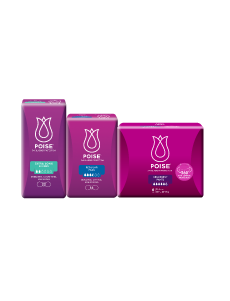Why the Natural Changes of Menopause?
Whether you’re in your late 40s, early 50s, or even closer to 60, going through menopause can be a difficult time. You may suffer one or all of the symptoms of mood swings, irrational feelings, irregular menstrual cycles, daily hot flushes, unexplained headaches or low confidence. Or, you may be one of the lucky ones who suffers no symptoms at all.
However, one symptom that is rarely discussed is the impact on women’s bladder control as they go through the natural changes of menopause.
Menopause causes hormone changes, such as the reduction of oestrogen, such that ligaments which hold your bladder in place will weaken and be less resilient, which causes the bladder to shift position slightly. This causes your pelvic floor muscles to be weakened and be less effective.
Here's some Nutrition and Lifestyle tips to help women going through menopause manage and control light bladder leakage:
Nutrition & Lifestyle Tips
Exercise
Walking, yoga, other regular exercise and pelvic floor exercises may ease some of your menopause symptoms including your mood. In general, exercise is excellent to keep the rest of your muscles fit and active to help support your pelvic floor muscles. POISE® Products also offer discreet protection with 2X more absorption than period products to help you exercise with peace of mind.
Keep your fluids up
Although you may think that not drinking is going to help, it actually worsens the problem as concentrated urine can lead to bladder infections. Drinking 1.5 litres, or 6-8 glasses of water a day will ensure your kidneys are well flushed and your bladder is getting proper training.
Watch your weight
Gaining weight can have a serious impact on your bladder and the supporting muscles of the pelvic floor muscles. The fluctuating hormone levels of menopause can lead to over-eating and weight gain, so keep an eye on that waistline.
Be careful not to worsen any conditions
Fluid retention and blood pressure are already under the influence of menopausal hormonal changes, so be sure to limit saturated fat and choose foods low in salt, so not to worsen any issues.
No “just in case” toilet trips
Try to get out of the habit of going to the toilet “just in case” as over time this can result in your bladder developing a smaller holding capacity. Try to hold on until you have at least 300 ml in your bladder (approximately 10 seconds of constant urine flow).
Food rules
Certain foods and drinks can irritate bladders. Citrus fruits, tomatoes or hot spices may have this effect on you. Try keeping a bladder diary to see which ones may be affecting your bladder weakness.
Alcohol and caffeine dehydrate the body by making more urine but they can also irritate the bladder making you want to urinate before you need to. Watch for their effects on you, so you can see when one cup or glass, is too many, or whether you should avoid these altogether.
Acupuncture
Acupuncture has shown itself to be a good option for women who are going through menopause as a US university study showed women who received a 7-week course of acupuncture reported a reduction in the severity of their nocturnal hot flushes.
Also, be sure to talk to your doctor, healthcare professional, or nurse continence advisor as they will help you determine, control and improve your condition.
Incontinence can affect women of all ages. POISE® liners and pads are specifically designed to help women easily manage bladder leakage in everyday life. Try now!
Where To Buy
These articles might also be interesting to you
Kimberly-Clark Singapore makes no warranties or representations regarding the completeness or accuracy of the information. This information should be used only as a guide and should not be relied upon as a substitute for professional medical or other health professional advice.
Sources
Arnold, J., McLeod, N., Thani-Gasalam, R. and Rachid, P. (2012). RACGP - Overactive bladder syndrome –management and treatment options. [online] Racgp.org.au. Available at:
http://www.racgp.org.au/afp/2012/november/overactive-bladder-syndrome/
[Accessed 6 Apr. 2015].
Bladderclinic.com.au, (2011). Overactive Bladder (OAB). [online] Available at:
http://www.bladderclinic.com.au/bladder/overactive-bladder-oab [Accessed 6 Apr. 2015].
Cherney, K. (2013). Home Remedies for Overactive Bladder. [online] Healthline. Available at:
http://www.healthline.com/health/overactive-bladder/home-remedies#Overview1
[Accessed 6 Apr. 2015].
Eilber, MD, K. (2015). What Is The Difference Between A Small Bladder And An .... [online] EmpowHER. Available at:
http://www.empowher.com/overactive-bladder/content/what-difference-between-small-bladder-and-overactive-bladder-dr-
[Accessed 6 Apr. 2015]
Maher, MD, C. (2003). Welcome to Chris Maher's Urogynaecology Australia Web Site. [online] Urogynaecology.com.au. Available at:
http://www.urogynaecology.com.au/Overactive.htm [Accessed 6 Apr. 2015].
Siamak N. Nabili, M. (2014). Overactive Bladder: Facts for Men, Women, and Children. [online] MedicineNet. Available at:
http://www.medicinenet.com/overactive_bladder/article.htm [Accessed 6 Apr. 2015].
Tidy, MD, C. (2013). Overactive Bladder Syndrome, Bladder Problems | Health | Patient.co.uk. [online] Patient.co.uk. Available at:
http://www.patient.co.uk/health/overactive-bladder-syndrome [Accessed 6 Apr. 2015].
Webmd.com, (2014). Overactive Bladder in Children (Child Incontinence): Signs, Causes, and Treatment. [online] Available at:
http://www.WebMD.com/urinary-incontinence-oab/overactive-bladder-in-children
[Accessed 6 Apr. 2015].
Canceraustralia.gov.au, (2019). Bladder cancer statistics in Australia | Bladder Cancer. [online] Available at:
https://bladder-cancer.canceraustralia.gov.au/statistics
[Accessed 6 Jun. 2019].
Other urinary incontinence causes









